Man-made star will call into space
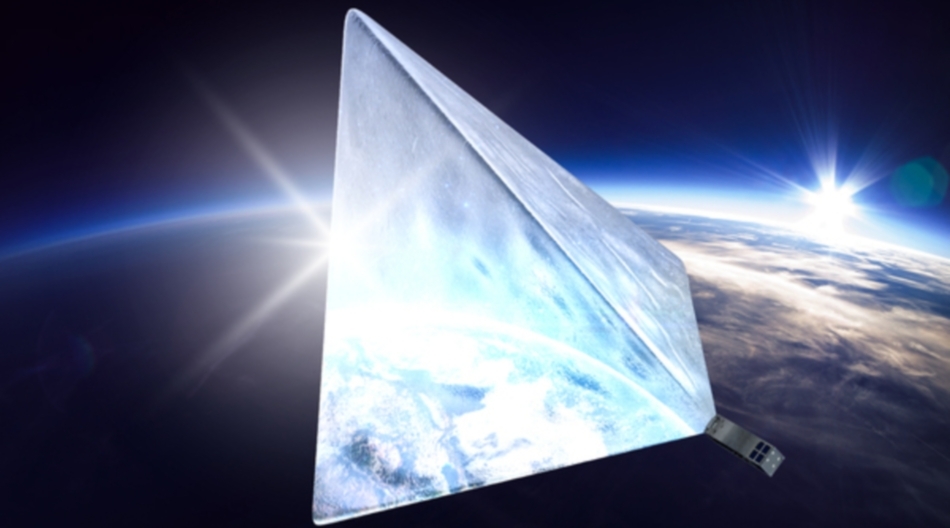
For more than a year, a team of enthusiasts has been making a microsatellite, which will have only one, but an unusual goal - the popularization of astronautics and a call for all of humanity to raise their heads and look at the sky. The satellite can go into space this summer and for several weeks become the brightest star. I interviewed the founder of the project, the head of the Modern Cosmonautics educational program at the University of Mechanical Engineering and the cosmonautics popularizer Alexander Shaenko.
People and ideas
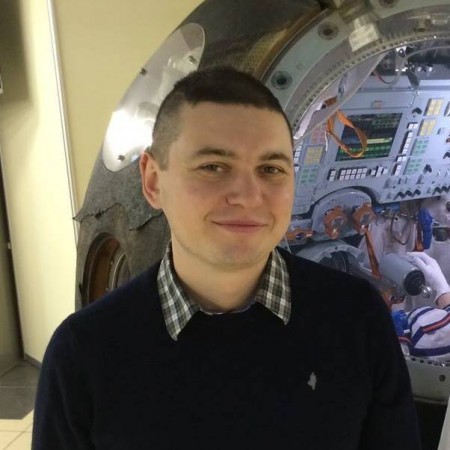
Alexander Shaenko has been working in the space industry for more than 10 years. He participated in the creation of the Angara and KSLV-1 launch vehicles, the DX1 satellite of the private Russian company Dauria Aerospace, and participated in the Selenokhod mini lunar rover project. In recent years, he has been conducting the All-Russian program of popular science lectures on cosmonautics (the project “Space from sea to sea”), created the course “Basic cosmonautics” for those who graduated from non-cosmic specialties in universities, organized the Summer Space School, created and leads the bachelor’s program. the program "Modern Cosmonautics" at the University of Mechanical Engineering.
')
Alexander, work on the satellite has already advanced far, but I still wonder where this idea came from? Why precisely star?
The idea of "Beacon" originated from two sides. Firstly, my experience in our rocket and space industry brought me to the thought that space achievements were in the past not because we had little money, not because people were stupid, and not because our equipment was weak . The fact is that even the industry workers themselves for the most part do not know why cosmonautics is needed. For what they themselves need manned flights, for which they build new launch vehicles, for which interplanetary stations. And because of this, our space plans are constantly changing or postponing, and projects last for decades. In my thoughts about it, I began to think about what exactly I personally can do to change this. I thought that if you show people what astronautics can give them personally, and this will be valuable for them, then this will change the attitude of society towards space exploration, and the attitude of the rocket and space industry towards their work.
For this, I began to speak with popular science lectures, in which I began to talk about the fact that astronautics is interesting, unusual, beautiful, fascinating. And after one of the lectures there was a second reason.
Secondly, at the very end of December 2013, Alexey Statsenko (aka MagisterLudi ) approached me after the lecture and asked how you could launch a satellite into space. I explained to him how this can be done and gave the address of the Cosmotras website. Then he asked if a brick could be launched into space. I replied that it was possible, but no one would see. It is much more interesting to launch into space what will be visible. In my mind, I figured it would be relatively easy to do this. And then I realized that if I manage to convene enthusiasts, make a satellite, which will be visible from orbit to the naked eye, then this can become a good example for people that astronautics has become available. That in order to launch real satellites into space, it is not necessary to work in a giant corporation, or to be a billionaire. And, as they say, wrap ...
In a symbolic form, these reasons are shown in our cartoon:
You already have a whole team of like-minded enthusiasts. What can you tell about them?
In addition to me and the "head of the department of psychological relief," Kvazar's pooch has a team of ten more. There are people working in the space industry, IT people, PR people, students, everyone does what he can and loves. In more detail, what they wanted to tell about themselves can be found here .
Design
As I understand it, the satellite should be fairly simple structurally. What will he be?
"Lighthouse" is made in the popular Cubesat format. These are satellites having limited, discretely specified dimensions. One satellite “discrete”, one unit, is 100 mm by 100 mm by 100 mm and weighs up to 1.33 kg. The format was coined for small satellites to be unified according to the launch method. For Kubsat, many launch containers were invented, in which they are put into orbit on different rockets, and from which they then go into space. Relatively speaking, any cubsat can be run in any container. This greatly reduced the cost and speed up launches.
The “lighthouse” is a cubsat for three units with dimensions of 100 mm by 100 mm by 340.5 mm. The mass of the device - 4 kg.
Structurally, it consists of the following systems:
- Drop-down solar reflector
- Control system,
- Power supply system,
- Jet engine,
- Housing
There is no radio transmitter on board; this greatly facilitates and reduces the cost of the launch coordination process.
Disassembled 3D satellite model
If there is no transmitter and receiver, then it turns out that the satellite will work according to the program embedded in it? Could you tell us about the timeline of the satellite?
The sequence diagram of the operation of the device from the moment of separation from the launch vehicle (QoS, separation contact) until the control system is turned off is as follows:
- KO + 0 seconds Turn on the control system.
- KO + 30 seconds. The beginning of the disclosure of the solar reflector.
- KO + 150 seconds. The end of the disclosure of the solar reflector.
- KO + 151 seconds. Spun jet engine launch.
- KO + 1951 seconds. Turn off the engine. Turn off the control system.
During this process, the Beacon will open a tetrahedron of polymer film, stretched on the frame, and will be spun on all axes with a total angular velocity of at least 1 rev / s.
Two minutes to open the reflector ... Is it so big?
Yes, our reflector is a regular tetrahedron with a side of 3 meters. The area of one side, as it is easy to calculate, will be 3.8 m 2 and the total area will be over fifteen square meters. According to our calculations, Mayak will have a magnitude of -10, which is brighter than any star. Going down, the satellite will sparkle even brighter, and before entering the atmosphere it will shine with a magnitude of -13, like a full moon!
And how did you manage to place
The metallized film from which the reflector is made is only 5 micrometers thick, 20 times thinner than a human hair. And we open it according to the roulette principle - three elastically deformable profiles (consider, the roulette cloths) are wound on drums and unwound by a gearmotor. As a matter of fact, we used roulettes for testing:
Tests of the deployment system, October 2015. Two tapes move along the floor as if in weightlessness (gravity is directed perpendicularly), the third tape cannot be unloaded under these conditions and does nothing
And why will you spin the satellite?
The satellite is twisted on all axes so that the spot of the reflected light as often as possible runs around the entire part of the planet visible from the spacecraft, which will allow seeing the “Beacon” to as many people as possible. The device will be twisted on all axes with a total angular velocity of at least 1 revolution per second.
If you look at the cyclogram, the satellite will twist for half an hour. Do you use any special engine?
The fact is that it is impossible to use pyrotechnics, toxic chemicals, high pressure in cubes. Therefore, for the spin we have developed an engine that operates on the thermal decomposition of ammonium carbonate. This substance is used in the food industry to loosen the dough and is not dangerous. The engine is a hermetically sealed compartment with a nozzle. Inside the compartment are the so-called replaceable reactor modules - this is an assembly of two electric heaters, between which is placed a package with extruded ammonium carbonate. The assembly is placed in a thermal braid, which, when the heaters are in operation, shrinks and keeps the heaters in contact with the reagent. There are two such modules in our reactor. This allows up to 30 minutes to have a thrust of up to 5 grams with a specific impulse of 80 seconds.
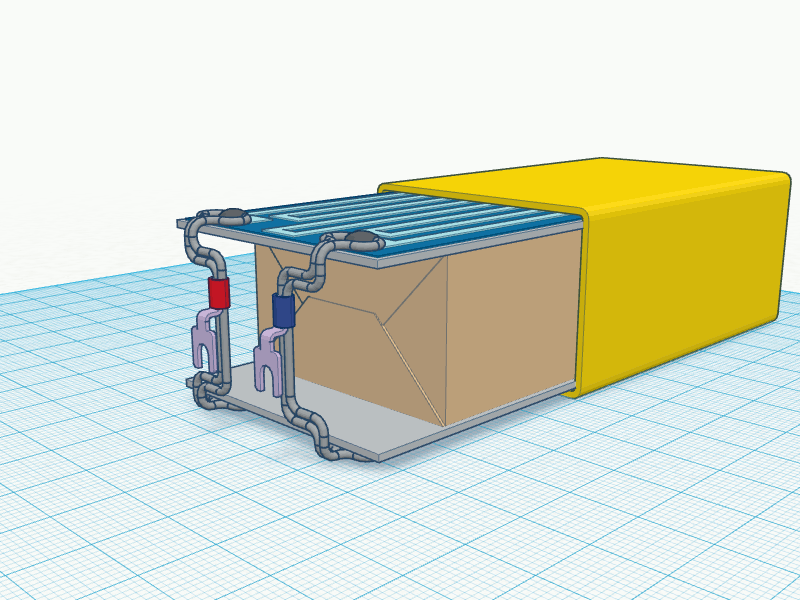
Scheme of work
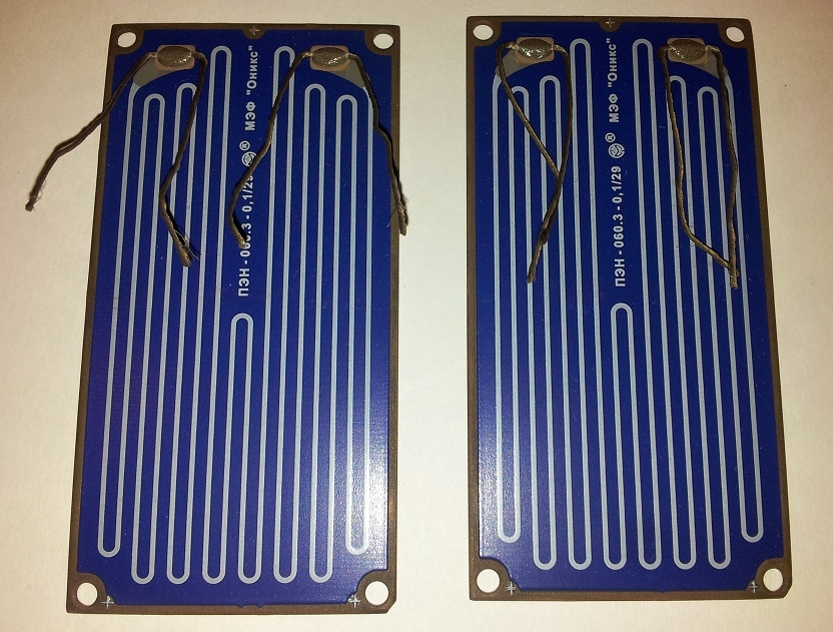
Manufactured heaters
Rocket
I was surprised when I heard that you managed to get a place on the rocket. Was it very difficult? Had to contact through institutions and other large organizations?
No, everything is easier. The rocket manages to get with the help of money, as elsewhere. But as long as the Beacon in the RN does not break away from the launching table, I will assume that we still could not get a place.
In the spring of 2015, we began to negotiate with the Sputnix company, which began to offer its services for the launch of Kubsat. A little later, the managers of the Glavkosmos company came to us, this is a kind of commercial interface of Roskosmos to foreign customers. Since there were not many of the industry’s hitherto precedents for launching Russian spacecraft, the very same Satellite on the Dnepr and Dauria Aerospace on the Soyuz-2, they probably also started to engage in student projects. Glavkosmos offered a better price, so we went to them. There are also foreign launch providers, for example, ISIS and Commercial Space Technologies , but they are more expensive.
And on what launch do you have an agreement?
We are preparing to launch on Soyuz-2 with RB Fregat. This carrier in June 2016 will be the spacecraft "Kanopus-V-IK", we will fly a passing cargo. The initial altitude of the orbit is 600 km, the orbit is sun-synchronous, the inclination is approximately 98 degrees. In this orbit, Mayak will last about 25 days.
Tests
If we imagine the amount of work required, then June seems to be a frighteningly near date. Have you already had a lot of tests?
Schematically, the test plan can be represented as follows:
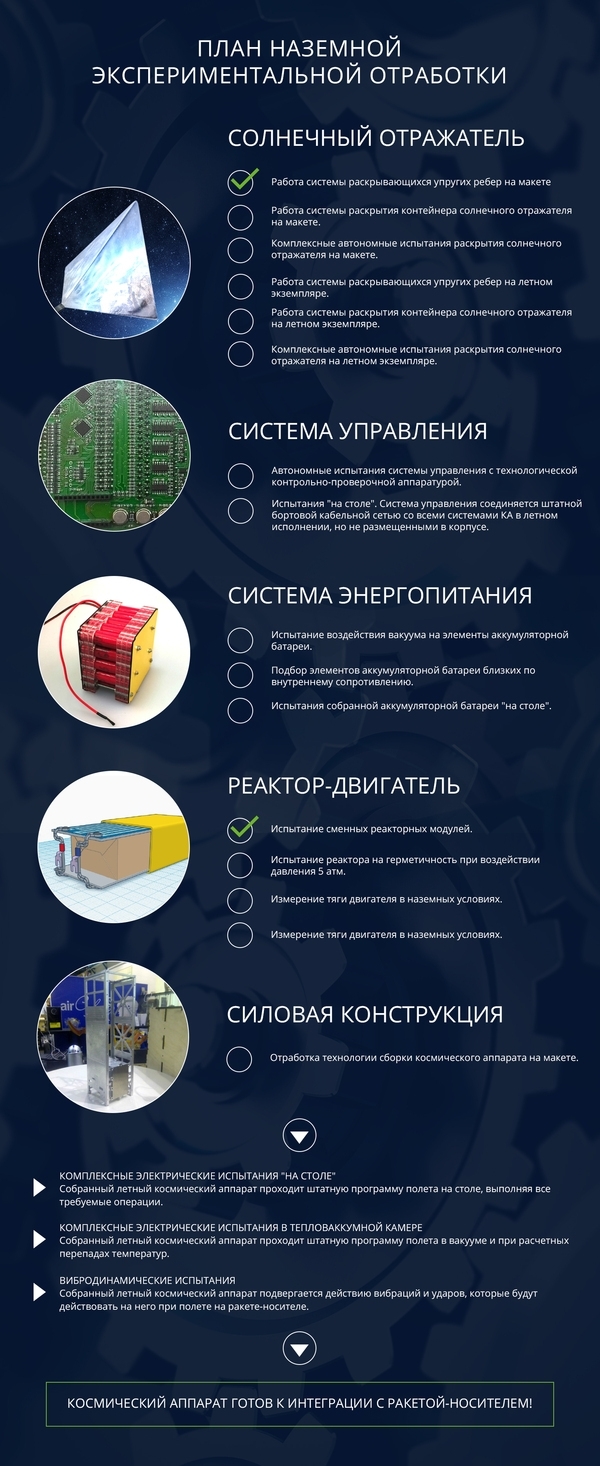
Those tests that have passed, showed that the systems work well.
On the model, the rib disclosure mechanism has been worked out; now the mock-up mechanism of the solar reflector assembly is being assembled. After these tests, it will be possible to proceed to the manufacture of the flight version of the solar reflector.
In social networks, I remember, I saw an instructive story of how you didn’t turn on the satellite mock-up on your stratospheric tests because of some offensive bug. What are you doing to ensure reliability?

Photos from stratospheric tests
Yes, then our telemetry and control equipment hung and started to reboot during the flight, so it did not issue a command to activate the satellite. He landed without even starting. And for the reliability of our satellite, we plan to do the following:
The power components, as the most loaded in the control system, are duplicated. Signal lines and mechanical controls (branch contacts, start key) are also duplicated. The logic scheme, in our opinion, is much more reliable and does not require duplication or other special measures to increase reliability.
Reliability of non-duplicated elements of satellite systems is ensured by their testing program — first system-by-system tests, then complex electrical “on the table”, then complex electrical ones in vacuum, and then vibrodynamic, with functional checks before and after the application of mechanical loads.
After the story with Phobos-Grunt, you involuntarily become afraid of heavy charged particles. What if it hits your non-duplicated management system?
We have provided software protection against TZCH. When working on flash, the current time is recorded, and upon rebooting, the transition to the last recorded step occurs. So the error may be introduced in the execution of the sequence diagram less than 0.1 s, which is not significant for our purposes. We do not have engines and orientation systems, as on Phobos-Grunt.
Money
In 2014, you successfully raised 407,000 rubles by crowdfunding. What did they do?
In short, more than a hundred thousand went to the stratospheric tests. Fifty thousand - for the manufacture of heaters. The rest is gifts to sponsors and the purchase of necessary tools and materials. The full report is available here .
And now, according to rumors, you are collecting half a million already. What will this money go to?
Current fees are a collection of money for making flight copies of a satellite, we want to make two of them, to pay for the tests and, in fact, for an orbital launch. Every little thing like prizes is also in the estimate.
On a large scale, the following expenses are planned:
- Production of two flight copies of the Mayak spacecraft 1.5 million rubles,
- Vibrodynamic testing, 1.5 million rubles,
- Heat vacuum testing, 2.5 million rubles,
- Orbital launch of 2.8 million rubles
- Non-technical expenses (prizes to sponsors, etc.) 0.7 million rubles.
If we manage to save money, we will spend money on additional iron mining.
Conclusion
Personally, I am embarrassed by the fact that the ISS has been flying for more than 15 years, it can be regularly observed, and, from my own experience, its observations are impressive. Than the "Lighthouse" will be better?
First, the "Lighthouse" will be brighter.
Secondly, “Mayak” will be visible on the whole Earth, from the North to the South Pole.
Thirdly, the "Mayak" will be made by the hands of enthusiasts, ordinary people who want to do cosmonautics. This is for me and for the project team the most important result. So we can change the attitude of society towards space exploration. We will be able to show that astronautics is interesting, beautiful, exciting. In order to do it, you do not need to have billions or work in a huge corporation. Wanted, gathered friends, launched a satellite into orbit. Roughly the same was done for humanity by the first Soviet satellite. Not equipped with scientific equipment, however, he was able to inspire many to engage in astronautics and forced many countries to engage in space exploration. We expect a similar effect for non-countries, but for enthusiasts.
In the official press release of Roskosmos, which I saw on your site, they write about other goals of the project - testing the aerodynamic system of converting satellites from orbit, studying the atmosphere and determining the brightness of objects. Is it a disguise or additional goals?
These are very real scientific tasks. Moreover, in my opinion, the aerodynamic braking system may have a commercial potential, since now, to bring the satellite down from orbit, it is required to have a control system and a propulsion system on board, and this is expensive and difficult. Using a design similar to the Mayak solar reflector, satellites can be reduced from orbit much easier and cheaper. Moreover, I have already received similar offers. A simple and cheap way to reduce satellites from orbit, especially small ones, will significantly reduce the risk of new space debris.
For scientists studying the upper atmosphere, "Beacon" is useful for its sensitive response to air density. In those places where the density is higher, the satellite will slow down faster and its orbit will decrease more strongly, and vice versa. Watching his flight, it will be possible to explore the upper atmosphere. And finally, “Mayak” can serve as a reference object for models for calculating the apparent stellar magnitude.
Well, in conclusion, let us dream. Suppose, "Mayak" was launched and successfully completed. What do you expect from the project?
I would be happy to understand that, thanks to the Mayak project, teams of people appeared in Russia and in the world, who began to engage in cosmonautics in a broad sense: they went to study astronautics, including me, to create space and rocket startups, to shoot about space, good films and writing books about it and the like. That in the world there was a request for space exploration. If this happens due to my efforts, then I will be immensely happy.
Team "Beacon" on Geektimes:
Alexander Shaenko - 4110
Source: https://habr.com/ru/post/390229/
All Articles